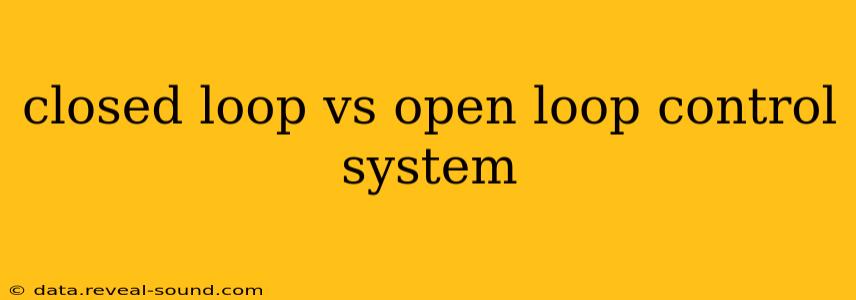Choosing the right control system for your application is crucial for efficiency and accuracy. Two fundamental types dominate the field: closed-loop and open-loop control systems. Understanding their differences is key to making informed decisions. This guide will delve into the specifics of each, highlighting their strengths and weaknesses.
What is a Closed-Loop Control System?
A closed-loop control system, also known as a feedback control system, uses feedback to regulate its output. This means it constantly monitors the output and compares it to the desired setpoint. Any deviation triggers a corrective action to bring the output back to the desired value. Think of a thermostat controlling room temperature: it measures the current temperature, compares it to the set temperature, and adjusts the heating or cooling accordingly.
Key Characteristics of Closed-Loop Systems:
- Feedback Mechanism: A crucial component is a sensor that measures the output and feeds it back to the controller.
- Error Correction: The controller compares the measured output to the setpoint and calculates the error. It then uses this error to adjust the control input.
- High Accuracy: Because of the continuous feedback and correction, closed-loop systems generally offer high accuracy and precision.
- Self-Regulating: They can adapt to changing conditions and disturbances, maintaining the desired output.
- More Complex: They tend to be more complex to design and implement than open-loop systems.
Examples of Closed-Loop Systems:
- Thermostat: Regulates room temperature.
- Cruise Control: Maintains a constant vehicle speed.
- Automatic Gain Control (AGC): Adjusts the gain of an amplifier to maintain a constant output level.
- Temperature Control in an Oven: Monitors and adjusts the internal temperature.
What is an Open-Loop Control System?
An open-loop control system, also known as a feedforward control system, doesn't use feedback to regulate its output. It simply executes a pre-determined sequence of actions based on the input. Imagine a washing machine completing its wash cycle without monitoring the cleanliness of the clothes. The outcome is entirely dependent on the initial programming and doesn't adapt to unforeseen circumstances.
Key Characteristics of Open-Loop Systems:
- No Feedback: They lack a feedback mechanism to monitor the output.
- Simple Design: They are simpler to design, implement, and maintain than closed-loop systems.
- Less Accurate: Their accuracy is limited by the precision of the input and the inherent characteristics of the system.
- Susceptible to Disturbances: External disturbances can significantly affect the output.
- Cost-Effective: Generally, they are cheaper to manufacture and operate.
Examples of Open-Loop Systems:
- Traffic Light: Operates on a pre-programmed timing sequence.
- Washing Machine (Basic Cycle): Follows a predetermined sequence of actions.
- Simple Sprinkler System: Waters the lawn for a fixed amount of time.
- DVD Player: Plays a disc from start to finish without monitoring playback quality.
Closed Loop vs. Open Loop: A Comparison Table
| Feature | Closed-Loop System | Open-Loop System |
|---|---|---|
| Feedback | Present | Absent |
| Accuracy | High | Low |
| Complexity | High | Low |
| Cost | Generally Higher | Generally Lower |
| Disturbance Sensitivity | Low | High |
| Adaptability | High (self-regulating) | Low (fixed sequence) |
| Examples | Thermostat, Cruise Control | Traffic Light, Simple Sprinkler System |
What are the advantages of a closed-loop system?
Closed-loop systems excel in accuracy and adaptability. Their feedback mechanism allows for continuous error correction, resulting in precise output even with variations in the environment or load. This self-regulation makes them ideal for applications requiring stability and consistency.
What are the advantages of an open-loop system?
Open-loop systems boast simplicity and low cost. Their absence of a feedback mechanism simplifies design and maintenance, making them cost-effective solutions for applications where precise control isn't critical.
When to use which system?
The choice between a closed-loop and an open-loop system depends on the specific requirements of the application. Closed-loop systems are preferred when high accuracy, stability, and adaptability are essential. Open-loop systems are suitable for simpler applications where cost is a major factor and high precision is not necessary. Consider factors such as accuracy requirements, cost constraints, complexity tolerance, and the presence of disturbances when making your decision.
This comprehensive guide provides a solid foundation for understanding closed-loop and open-loop control systems. By carefully weighing the advantages and disadvantages of each, you can select the most appropriate control system for your specific needs.
